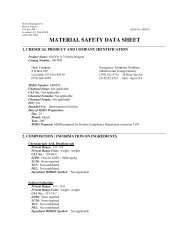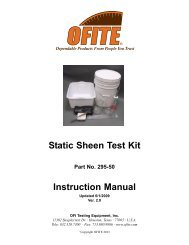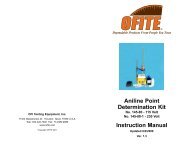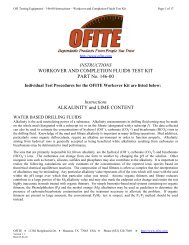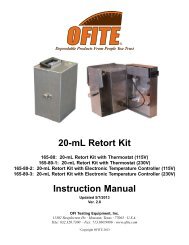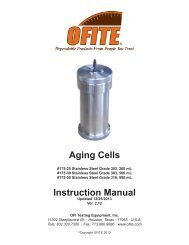MATERIAL SAFETY DATA SHEET - OFI Testing Equipment, Inc.
MATERIAL SAFETY DATA SHEET - OFI Testing Equipment, Inc.
MATERIAL SAFETY DATA SHEET - OFI Testing Equipment, Inc.
You also want an ePaper? Increase the reach of your titles
YUMPU automatically turns print PDFs into web optimized ePapers that Google loves.
<strong>MATERIAL</strong> <strong>SAFETY</strong> <strong>DATA</strong> <strong>SHEET</strong><br />
Mineral Oil Calpar 100®<br />
SECTION 1 . Product and Company Idenfication<br />
Product Name and Mineral Oil Calpar 100®<br />
Product Code: 120-001<br />
Material Uses: Health: 1<br />
<strong>OFI</strong> <strong>Testing</strong> <strong>Equipment</strong> <strong>Inc</strong>. Flammability: 1<br />
Manufacturer:<br />
11302 Steeplecrest Dr. Reactivity: 0<br />
Houston, TX 77065<br />
(877) 837-8683<br />
Entry Date : 7/15/2013 Established<br />
Print Date: 7/15/2013<br />
24 Hour Emergency Assistance : INFOTRAC USA - CANADA: 1-800-535-5053<br />
INTERNATIONAL: 1-352-323-3500<br />
SECTION 2 HAZARD IDENTIFICATION<br />
Hazard Rating:<br />
Least Slight Moderate High<br />
Extreme<br />
0 1 2 3 4<br />
NA=Not Applicable NE=Not<br />
Generally not hazardous in normal handling, however good laboratory<br />
practices should always be used. Avoid long term exposure to skin or<br />
by inhalation.<br />
Emergency Overview: Not expected to cause a severe emergency hazard. This product is a<br />
water-white to light amber, viscous liquid. It has a light, mildly petroleum odor. The product floats<br />
on water. This product is slightly combustible (Flammability Class IIIB) but will burn. Heated<br />
product will produce colorless vapors. Heated vapors in the presence of an ignition source can be<br />
explosive, if confined.<br />
Inhalation:<br />
No significant adverse health effects are expected to occur upon short-term exposure.<br />
Ingestion: If swallowed, large volume of material can cause generalized depression, headache,<br />
drowsiness, nausea, vomiting, and diarrhea. Smaller doses can cause a laxative effect. If<br />
aspirated into<br />
lungs, liquid can cause lung damage.<br />
Skin:<br />
This product can cause mild, transient skin irritation with short-term exposure.<br />
SECTION 3 MIXTURE COMPONENTS<br />
Eye Contact: This product can cause transient mild eye irritation with short-term contacts with<br />
liquid sprays or mists.<br />
Exposure<br />
Percent<br />
Limits<br />
SARA 313 Component CAS Number Comp. Dimension<br />
Paraffin Oil, White CAS# 8042- 100% V/V OSHA TWA 5<br />
Drakeol® 19 Min Oil USP 47-5 mg(mist)/mƒ<br />
SECTION 4 FIRST AID MEASURES<br />
Generally not hazardous in normal handling, however good laboratory practices should<br />
always be used. Avoid long term exposure to skin or by inhalation.<br />
FIRST AID: SKIN: Wash exposed area with soap and water. If irritation persists, seek<br />
medical attention.<br />
EYES: Wash eyes with plenty of water for at least 15 minutes, lifting lids occasionally.<br />
Seek Medical Aid. INHALATION: Remove to fresh air. If not breathing, give artificial<br />
respiration. If breathing is difficult, give oxygen
Mineral Oil Calpar 100®<br />
INGESTION: Give several glasses of milk or water. Vomiting may occur<br />
spontaneously, but DO NOT INDUCE! Never give anything by mouth to an<br />
unconscious person.<br />
SECTION 5 FIRE FIGHTING MEASURES<br />
Fire Extinguisher Type: Water spray, Carbon dioxide, dry<br />
chemical, powder, foam.<br />
Dense smoke may be generated while<br />
Fire / Explosion Hazards: burning. Carbon dioxide, carbon monoxide<br />
Fire Fighting Procedure:<br />
SECTION 6 ACCIDENTAL RELEASE MEASURES<br />
nitrogen and sulfur oxides may be<br />
Wear self-contained breathing apparatus and protective<br />
clothing to prevent contact with skin and clothing.<br />
Absorb spill with inert material, then place in a chemical<br />
waste container. Remove all sources of ignition. Dispose<br />
of in a manner consistent with federal, local law.<br />
Protective Measures:May burn although not readily ignitable. Wear<br />
appropriate personal protective equipment when<br />
cleaning up spills. Refer to Section 8.<br />
Spill Management:FOR LARGE SPILLS: Remove with vacuum<br />
truck or pump to storage/salvage vessels.<br />
FOR SMALL SPILLS: Soak up residue with an absorbent such as<br />
clay, sand or other suitable<br />
material. Place in non-leaking container and seal tightly for proper<br />
disposal. Remove contaminated soil to remove contaminated trace<br />
residues. Dispose of in same manner<br />
as material.<br />
Reporting:CERCLA: Product is covered by EPA's Comprehensive<br />
Environmental Response,<br />
Compensation and Liability Act (CERCLA) petroleum exclusion.<br />
Releases to air, land, or water<br />
are not reportable under CERCLA (Superfund). CWA: This product<br />
is an oil as defined under<br />
Section 311 of EPA's Clean Water Act (CWA). Spills into or leading<br />
to surface waters that cause a sheen must be reported to the<br />
National Response Center,<br />
1-800-424-8802.<br />
SECTION 7 HANDLING AND STORAGE<br />
Keep away from heat and flame. Do not get in eyes,<br />
on skin, on clothing. Use with adequate ventilation.<br />
SECTION 8 EXPOSURE CONTROLS/PERSONAL PROTECTION<br />
Respiratory Protection:<br />
Ventilation<br />
Protective Gloves:<br />
Eye Protection:<br />
No special protection required unless heated<br />
Local<br />
Mechanical<br />
Gloves to prevent exposure<br />
Splash Goggles<br />
Page 2 of 5
Mineral Oil Calpar 100®<br />
Other Protective <strong>Equipment</strong>: generated. Wear appropriate clothing to prevent<br />
skin exposure<br />
TWA: 5 STEL: 10 (mg/m3) as oil mist Consult local authorities for<br />
acceptable exposure limits.<br />
SECTION 9 PHYSICAL AND CHEMICAL PROPERTIES<br />
Melting Point: Information Percent Volatile by 0<br />
not available<br />
Boiling Point: 310°C Evaporation Rate Information not<br />
available<br />
Vapor Pressure: 0.1 kPa (@ Evaporation Standard<br />
20°C)<br />
Vapor Density: Information Auto Ignition Temp 625°F<br />
not available<br />
Solubility in Water: Insoluble Lower Flamm. Limit in Air Information not<br />
available<br />
Appearance /Odors: Transparent Upper Flamm. Limit in Air Information not<br />
water-white<br />
available<br />
liquid/odorless<br />
Flash Point:<br />
168.33°C<br />
Specific Gravity: 0.858<br />
SECTION 10 STABILITY AND REACTIVITY INFORMATION<br />
Stability:<br />
Conditions to Avoid:<br />
Stable<br />
Temperature extremes, ignition sources<br />
Materials to Avoid:<br />
Hazardous Decomposition<br />
Products:<br />
Hazardous polymerization:<br />
Conditions to Avoid:<br />
SECTION 11<br />
pressure and is not expected<br />
Strong oxidizing agents<br />
Oxides of carbon, Nitrogen and Sulfur.<br />
Will Not Occur<br />
None known<br />
Toxicological Information<br />
Routes of Entry: Absorbed through skin. Eye contact.<br />
Toxicity to Animals:<br />
LD50: Not available. LC50: Not available.<br />
Chronic Effects on Humans: CARCINOGENIC EFFECTS: 3 (Not classifiable for human.) by<br />
IARC.<br />
Other Toxic Effects on Humans:<br />
Slightly hazardous in case of ingestion. Non-irritant for skin. Non-hazardous in case of<br />
inhalation.<br />
Special Remarks on Toxicity to Animals: Not available.<br />
Special Remarks on Chronic Effects on Humans:<br />
Highly refined mineral oils are not classified as human carcinogens. However, related forms<br />
(untreated and mildly-treated oils<br />
used in metal machining, mule spinning and jute processing) are listed as human carcinogens by<br />
both IARC (group 1) and<br />
NTP<br />
Special Remarks on other Toxic Effects on Humans:<br />
Potential Health Effects: Skin: This product is not expected to cause any skin irritation upon direct<br />
single or repeated and<br />
prolonged contact. However, similar chemical compositon products applied to the skin of lab<br />
animals resulted in minimal<br />
to slight dermal irritation. Eyes: May cause mild (minimal) eye irritation. Inhalation: May cause<br />
respiratory tract irritation<br />
Page 3 of 5 with coughing and shortness of breath. This product has a low vapor
to present an inhalation<br />
hazard at ambient conditions. Caution should be taken to prevent aerosolization or misting. If<br />
aspiration occurs, it may<br />
lead to chemical pneumonitis which is characterized by pulmonary edema and hemorrhage and<br />
may be fatal. Signs of lung<br />
involvement include increased respiratory rate, increased heart rate, and bluish discoloration of<br />
the skin. Coughing, choking<br />
and gagging are often noted at the time of aspiration Ingestion: Ingestion is relatively non-toxic<br />
unless aspiration occurs. It<br />
has laxative properties and may cause gastrointestinal tract discomfort, abdominal cramps,<br />
vomiting and diarrhea. Exposure<br />
to a large single dose, or repeated small doses by inhalation, aspiration or ingestion leading to<br />
aspiration can lead to lipid<br />
pneumonia or lipid granuloma. These are low-grade, chronic localized tissue reactions which are<br />
not fatal.
Mineral Oil Calpar 100®<br />
SECTION 12<br />
SECTION 13<br />
SECTION 14<br />
Ecological Information<br />
Ecotoxicity: Not available.<br />
BOD5 and COD: Not available.<br />
Products of Biodegradation:<br />
Possibly hazardous short term degradation products are not likely. However, long term<br />
degradation products may arise.<br />
Toxicity of the Products of Biodegradation: Not available.<br />
Special Remarks on the Products of Biodegradation: Not available.<br />
Disposal Considerations<br />
Waste must be disposed of in accordance with federal, state and local environmental control<br />
regulations.<br />
Transport Information<br />
DOT Classification: Not Regulated<br />
DOT Regulations may change from time to time. Please consult the most recent D.O.T. regulations.<br />
SECTION 15<br />
SECTION 16<br />
Regulatory Information<br />
Federal and State Regulations: TSCA 8(b) inventory: Mineral oil<br />
Other Regulations: EINECS: This product is on the European Inventory of Existing Commercial<br />
Chemical Substances.<br />
Other Classifications:<br />
WHMIS (Canada): Not controlled under WHMIS (Canada).<br />
DSCL (EEC):<br />
This product is not classified according to the EU regulations. Not applicable.<br />
Additional Information<br />
Page 4 of 5
Mineral Oil Calpar 100®<br />
Flammability<br />
Health<br />
Reactivity<br />
Revisions<br />
NFPA<br />
7/28/2010 0.1 updated msds to 16 section from 10<br />
section msds. STN<br />
7/9/2012 0.2 Revised ingredient from Calpur 1 oil to<br />
Drakeol 19 oil. LS<br />
The information herein is believed to be accurate and is offered in good faith for the<br />
user's consideration and investigation. No warranty either expressed or implied is made<br />
for the completeness or accuracy of the information whether originating from the above<br />
mentioned company or not. Users of this material should satisfy themselves by<br />
independent investigation of current scientific and medical knowledge that the material<br />
Page 5 of 5



